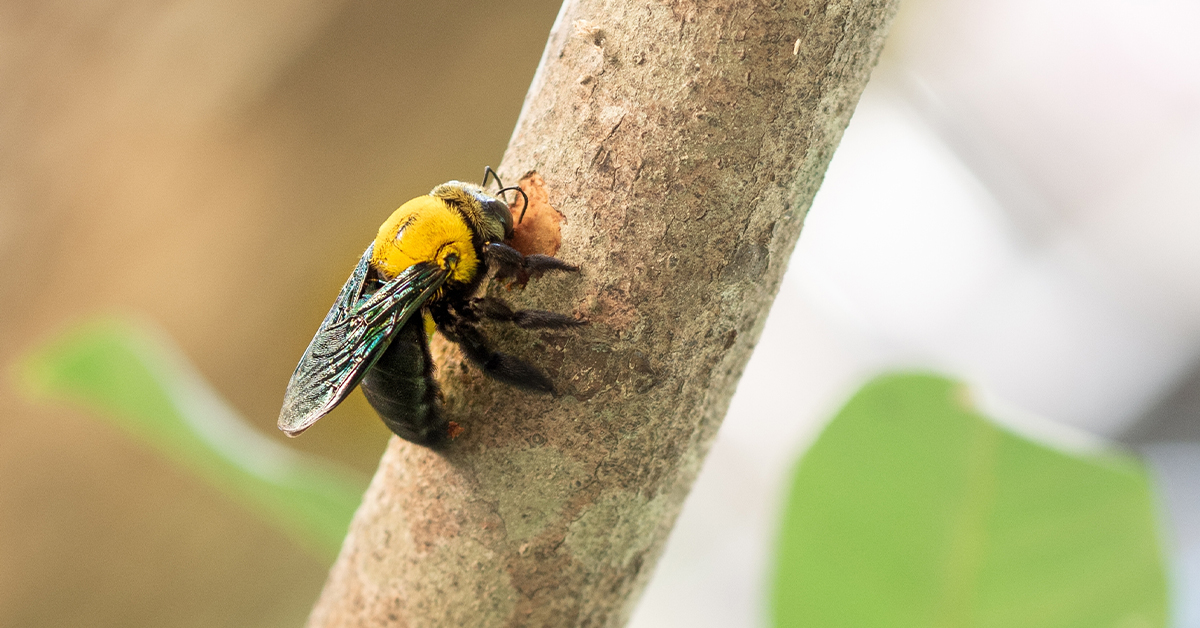It’s summertime, and suddenly there are a few mysterious holes in your siding, deck, or other wood areas of your home. You prod one of the holes and a little sawdust comes out. Then you see it… a dark, fuzzy bee that has been droning around the yard enters the hole. “What in the world is going on here?” you may wonder.
If this has happened to you, there’s a good chance carpenter bees have taken up residence on your property. Carpenter bees are a member of the bee species that drill holes in wood to build their nests. Female carpenter bees use their powerful mandibles to bore into wood in a circular motion. This creates a round hole that over time is expanded into a maze of channels and chambers. These tunnels eventually weaken the wood and damage the integrity of the structure in which they’re built.
How Do You Identify a Carpenter Bee Hole?
Carpenter bee damage begins with a perfectly round hole approximately 3/8 inch in diameter on a wood surface. An average hole will lead to a 6 – 10 inch deep tunnel partitioned into multiple chambers… each holding an egg and a supply of pollen to feed it. There may be a sawdust-like material (called frass) near the opening.
Carpenter bees tend to feed on untreated or unfinished soft woods like cypress, redwood, cedar, or pine, but they will nest in whatever wood is available. There may be multiple holes drilled in a single structure – which indicates your home has been occupied by more than one set of bees.
What Time of Year Do Carpenter Bees Make Holes?
Carpenter bees start making holes when they emerge from their old nest tunnels in the early spring. They are active throughout the spring and summer months, and then they hibernate (or die off) when temperatures dip into the low 50s in the fall.
How Long Does It Take a Carpenter Bee to Bore a Hole?
Carpenter bees drill into a wood surface at the rate of an inch every five or six days. It may not seem like much but, over the course of the spring and summer, a carpenter bee will dig out multiple channels with chambers in which to lay her eggs.
Some of these channels can be several feet long. So, you can experience serious damage to wood structures if a carpenter bee problem isn’t addressed in a timely fashion.
How Many Carpenter Bees Live in One Hole?
Unlike most other types of bees, carpenter bees aren’t particularly social. They don’t live in hive communities… rather, a male-female pair occupies one hole.
Carpenter bees don’t mind living near each other though. Multiple pairs will often bore into and occupy the same wood structure. They will even return to the same structure year after year, continuing to bore deeper into it and adding more egg chambers.
What Should You Do with a Carpenter Bee Hole?
If you discover a carpenter bee hole, it will need to be plugged. Preferably when the bees are not in residence! You can seal the holes with wood putty, caulk, or cork – any of which will prevent them from entering the nest. Because these bees prefer bare and untreated wood, you can discourage their return by finishing or painting wood surfaces.
Carpenter bee holes should be sealed as soon as possible. They can allow water to enter your home and they also attract woodpeckers looking for a tasty bee meal.
Because carpenter bees often return to previous nesting sites, you may require the services of a professional pest control company to remove them once and for all.
Twin Forks Pest Control® Evicts Carpenter Bees from Your Home
Carpenter bees aren’t a direct threat to people and pets… but they can do considerable damage to your home. The trained professionals at Twin Forks Pest Control® can eliminate an active infestation and treat your home to prevent bees from tunneling. Call us today for a free estimate.

